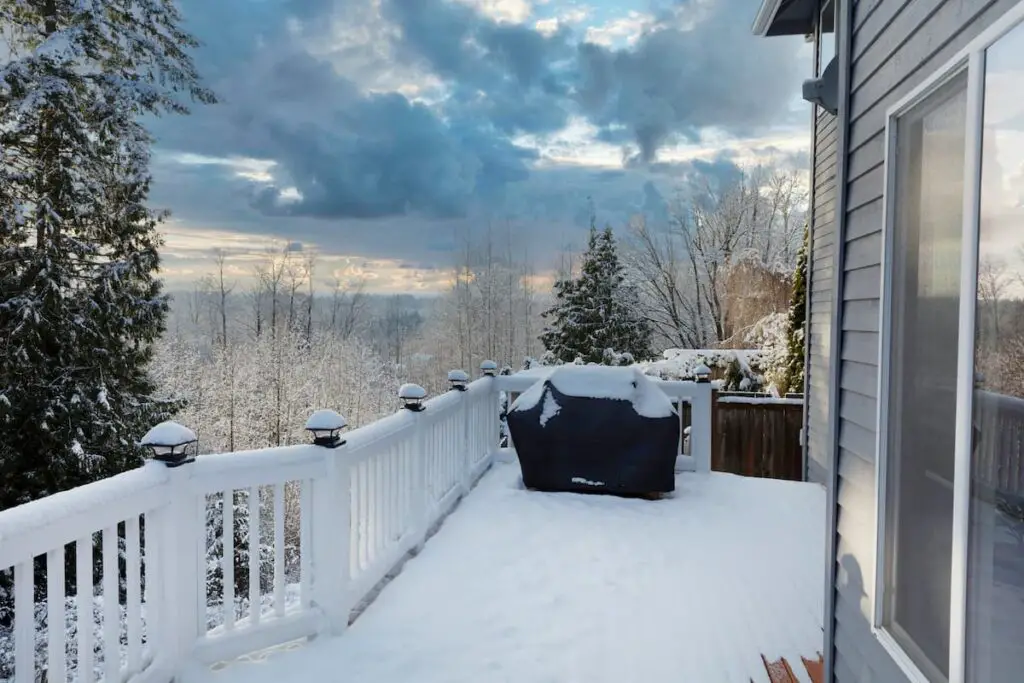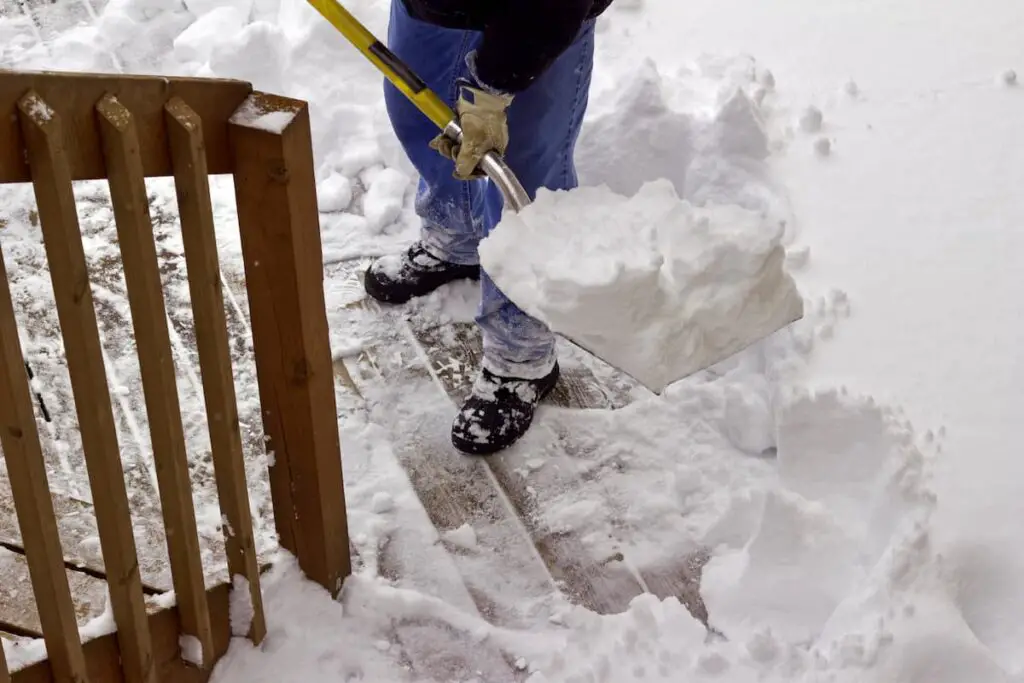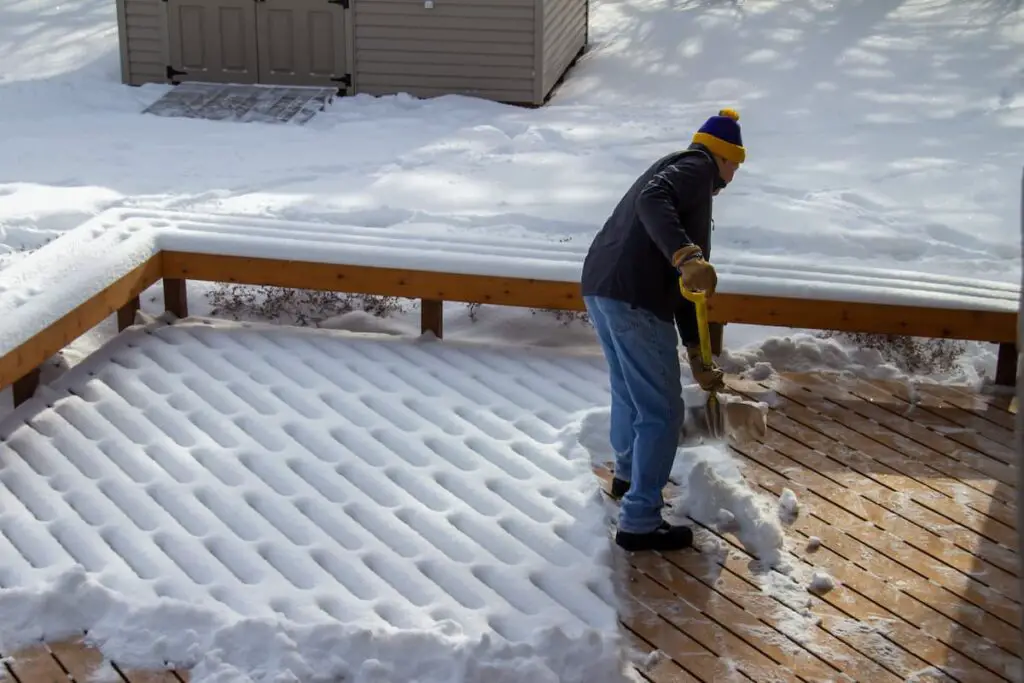As an Amazon Associate, we earn from qualifying purchases. We may also earn commissions if you purchase products from other retailers after clicking on a link from our site.
A balcony is ideal for enjoying the outdoor view and some fresh air. However, the thoughts of it collapsing due to snow build-up can send shivers down your spine. So, how much snow can collapse a balcony?
Snow of more than 100 lbs (45.35 kg) on 1 sq ft (0.09 sq m) of a balcony can collapse a balcony. However, the carrying capacity of a balcony will depend on several factors. These include its size, structure, and the materials used to construct it.
Snow build-up on your home’s exterior, including the balcony, roof, and deck, can have detrimental effects. The rest of this article will discuss a few topics related to the question in great detail.

Can Snow Collapse a Balcony?
Snow can collapse a balcony, especially if you let it pile up through the season. Although many balconies are structurally built to withstand different weights, overloading a balcony is dangerous. The condition of your balcony can also determine how much weight it can hold.
If your balcony is strongly built, you may have no reason to worry about its collapse. However, depending on its carrying capacity, a huge snow load can make it unstable, and if this weight exceeds its carrying capacity, the snow can collapse your balcony.
Here are factors that can make your balcony collapse from a snow load:
- Age and condition: If your balcony has been around for over 15 years, chances are that its structure is not as firm as it was when newly constructed. Moreover, if it has experienced damage due to water leaks, dry rot, rust, or corrosion, it may not support a lot of weight. Therefore, too much snow can collapse such a balcony.
- Building materials used: Some materials are more sturdy and weather-resistant than others. For instance, aluminum, plastic, concrete, and treated lumber can withstand weather elements. But, if your balcony is made from untreated wood or any material that soaks in water, it will eventually decay and risk collapsing.
- Poor construction: If your balcony isn’t constructed properly, it becomes susceptible to collapse, especially when overloaded. Therefore, if snow accumulates on such a balcony, exceeding its holding capacity, it will probably come down. Cantilevered balconies have the highest risk of collapsing due to their design. Since the beams holding them only have single support, they usually become unstable when overloaded.
- Overloading: Even though your balcony is in perfect condition, it is not immune to collapse. If it carries more weight than it can normally hold, there are high chances that it will collapse. Therefore, it’s crucial to know your balcony’s carrying capacity and regularly inspect it for any structural defects.
How Much Snow Can a Balcony Hold?
Most balconies can hold 50 to 100 lbs (22.7 to 45.4 kg) of snow per sq ft (0.09 sq m). However, a poorly constructed or structurally damaged balcony will withstand a lesser weight. So try not to overload your balcony.

Balconies have different designs, sizes, and construction materials, meaning that they’ll also have varying carrying capacities. Additionally, the weight that a balcony can hold includes the live and the dead loads.
Live load refers to the temporal weight on the balcony, including furniture, potted plants, or people.
Conversely, the dead load is the total weight of the materials used to construct and support a balcony. Hence, to avoid damage and safety hazards, you shouldn’t exceed the total weight of the live and dead loads.
Small balconies usually hold approximately 50 lbs (22.7 kg) per sq ft (0.09 sq m), while larger ones can withstand up to 100 lbs (45.4 kg) per sq ft (0.09 sq m). However, factors such as weather or a balcony’s condition will affect how much weight a balcony can hold at a specific time.
Therefore, if snow piles up on your balcony, it will exceed its carrying capacity.
Although your balcony’s carrying capacity will determine how much weight it can hold, a few signs can indicate that it will withstand that weight.
These include:
- Cracks: If your balcony has some cracks, this means that its structural integrity is compromised. Additionally, it will withstand lesser weight than its carrying capacity. Therefore, a heavy snow load will render it a safety hazard.
- Sagging: If your balcony is aged and its support system has weakened over time, it can sag if people lean on it frequently. A sagging balcony is dangerous, and too much weight will lead to its collapse.
- Rust: Since balconies are outward house extensions, they’re usually exposed to weather elements. If your balcony comprises rust-prone materials, it will rust due to consistent exposure to moisture. The effects of rust can contribute to damage, especially when the balcony exceeds its carrying capacity.
- Damaged or missing parts: These make your balcony susceptible to damage or other safety issues. For this reason, it’s advisable to inspect your balcony regularly to identify any missing or worn-out parts.
Should you Remove Snow from your Balcony?
You should remove snow from your balcony to avoid overloading it and potentially damaging the structure altogether. However, consult your landlord first if you’re in a rented apartment.
Removing snow from your balcony will prevent overload and structural damage. Moreover, it’s crucial to choose the best method to minimize snow build-up on your balcony.

Here are two effective ways of reducing snow on balconies.
Shoveling
Shoveling is the easiest way to remove snow from your balcony. However, you should do it carefully not to damage the floor. You’ll want to avoid using metal shovels or brooms to clear snow from your balcony.
It’s also not prudent to dump the snow on the balconies below or the roads. Therefore, use a bucket to carry the shoveled snow and empty it into your bathtub. Then, pour hot water into the snow to melt it.
De-icing or Melting the Snow
If shoveling is too much work, you can de-ice or melt the snow on your balcony. Various de-icing products are available in the market. But, some may corrode your balcony floor, while others have toxic chemicals.
It is, therefore, crucial to read the product’s composition and what it is intended for before you use it.
Alternatively, you can use hot water with a little salt to melt the snow. Nonetheless, salt can accelerate rusting on some materials such as metal and steel.
You can also use a calcium chloride solution but always rinse the surface afterward.
Preventing Snow Build-up
Removing snow from a balcony can be time-consuming and tiresome. So, you can opt to prevent the snow from piling on the balcony.
For instance, you can place heat mats on the balcony floor before it starts snowing. Heat mats are electrical mats that will warm the surface and will melt the snow when it reaches the floor. But, this will cost you some money due to the energy consumption.
Parting Shot
Although your balcony can hold a specific weight, snow build-up can lead to collapsing. Therefore, remove snow from your balcony before it exceeds the carrying capacity. Also, inspect it regularly to ensure that its structural integrity is intact.
